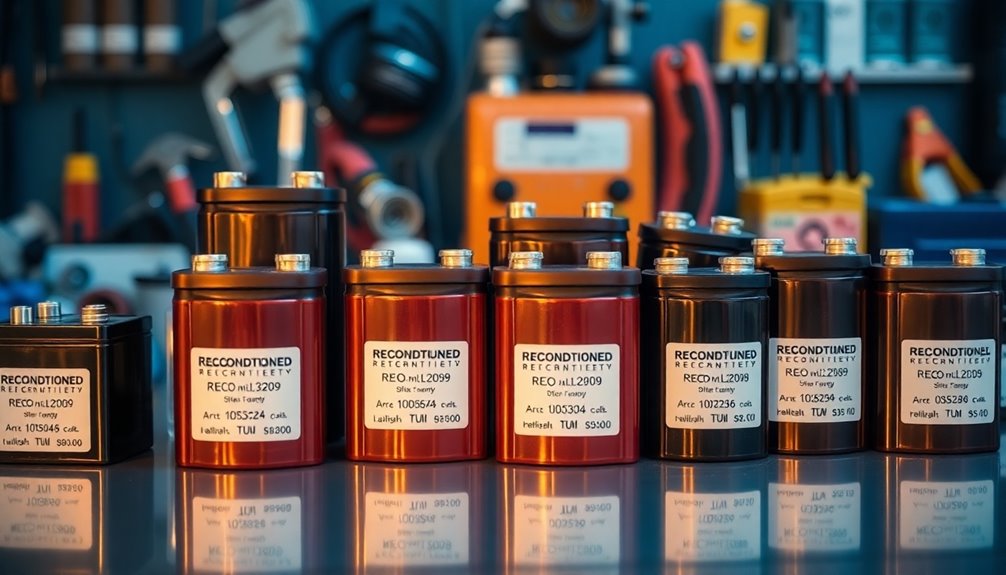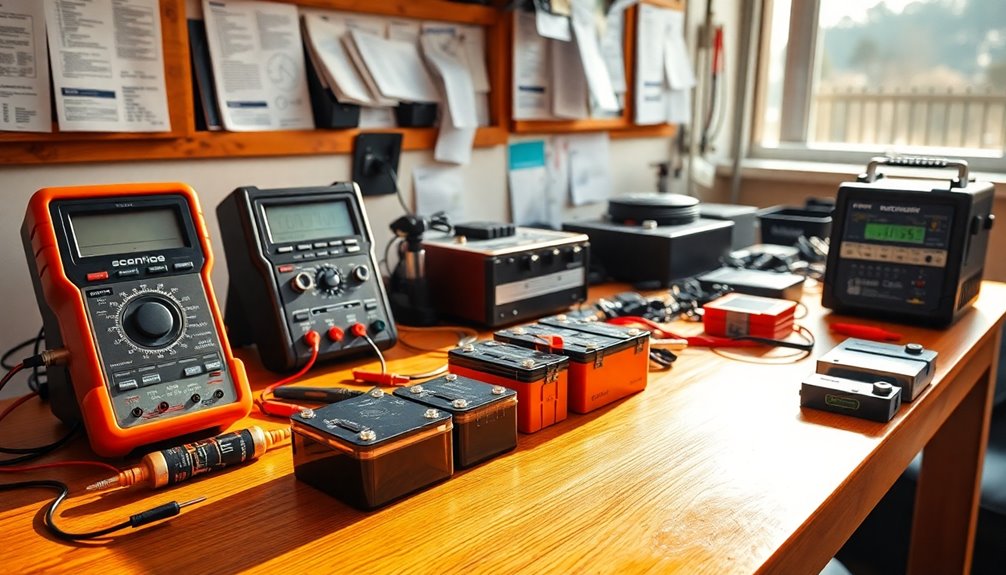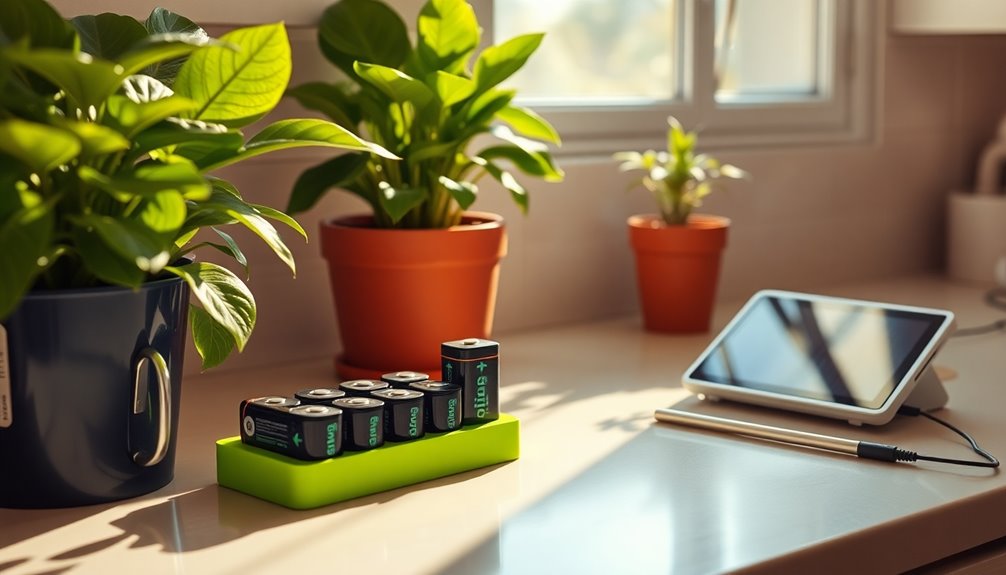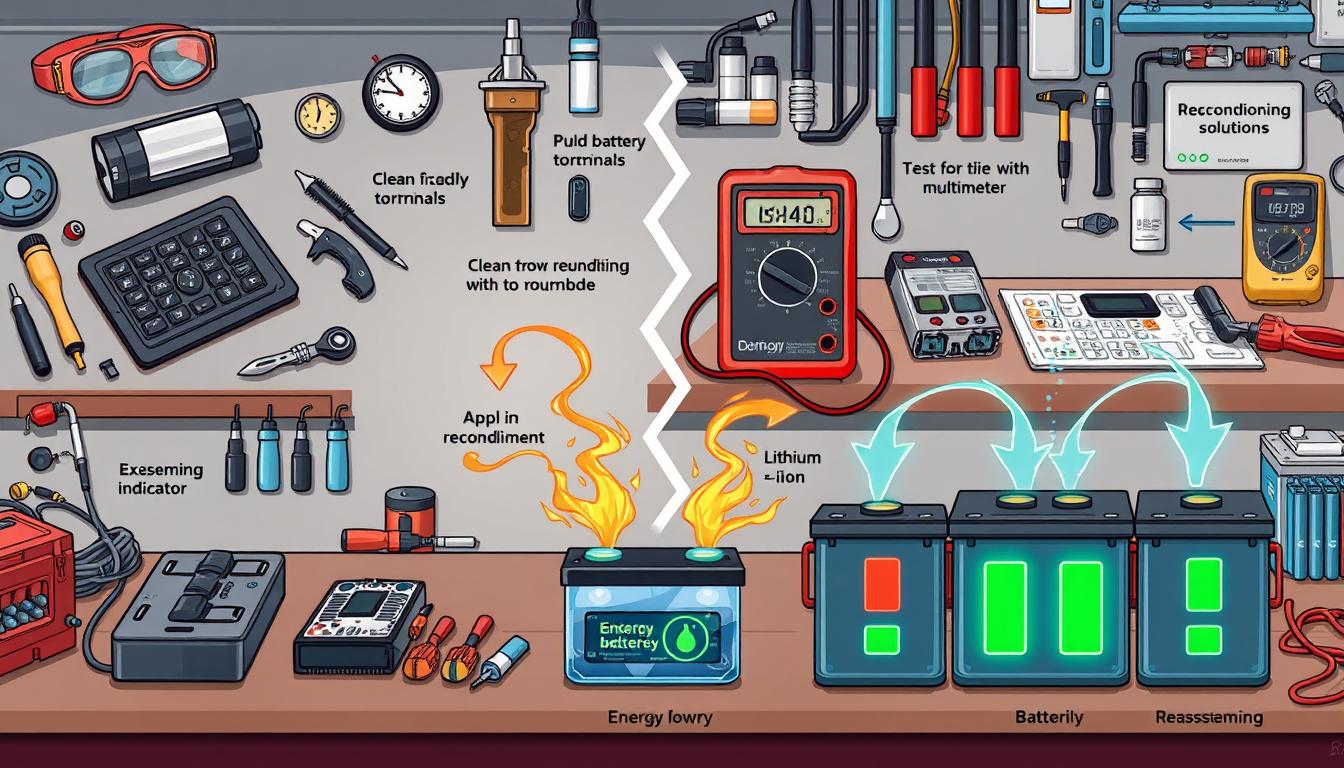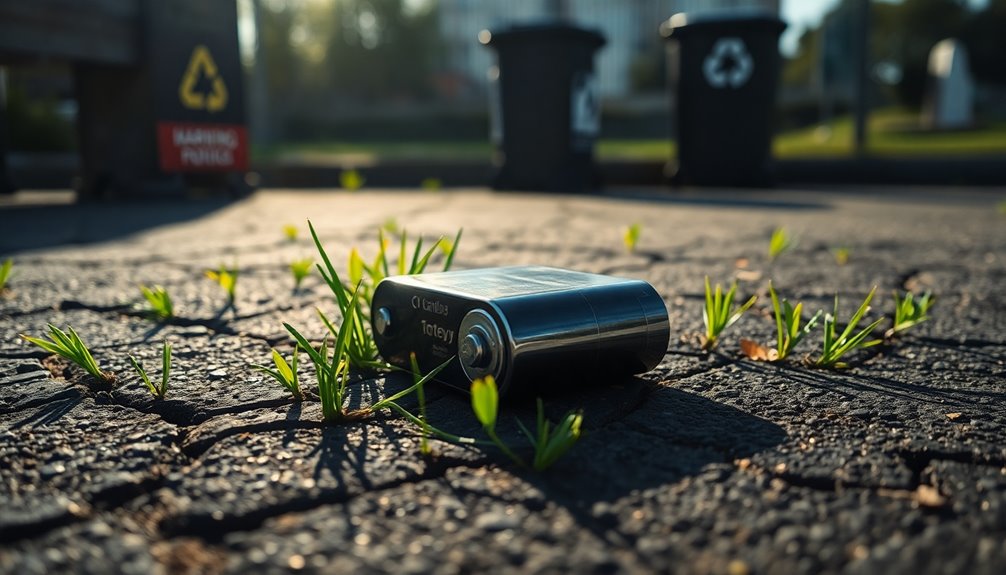You should buy reconditioned batteries when you're aiming to save money and reduce your environmental impact. They typically cost up to 75% less than new models, making them great for budget-conscious consumers. Plus, reconditioned batteries help conserve raw materials and reduce carbon emissions. Look for warranties that range from 1 to 5 years to ensure you're getting a quality product. Just be mindful that performance may vary based on the refurbishment process and seller. If you're curious about factors influencing your decision or the best applications for these batteries, there's still more to explore.
Key Takeaways
- Buy reconditioned batteries when you need cost savings, as they can be up to 75% cheaper than new batteries.
- Consider reconditioned batteries for environmentally conscious choices, as they reduce the demand for new materials and minimize landfill waste.
- Purchase reconditioned batteries when warranties are offered, typically ranging from 1 to 5 years, ensuring quality and peace of mind.
- Opt for reconditioned batteries for applications like frequency regulation, where immediate financial relief and long-term savings are beneficial.
- Choose reconditioned batteries when repurposing opportunities exist, as they can retain 70-80% capacity for other uses, supporting sustainability efforts.
Cost Savings of Reconditioned Batteries

When you're considering battery replacements, you'll find that reconditioned batteries can be a budget-friendly option that doesn't compromise on value.
These batteries are generally much more affordable than new ones, making them an attractive choice for those of you looking to save money. For instance, if you own a Toyota Prius, opting for a reconditioned battery can lead to substantial cost savings compared to purchasing a new one. While the initial price is lower, reconditioned batteries often come with warranties or guarantees, adding another layer of value. If you're mindful of your budget, this price difference could be crucial for your financial plans without sacrificing performance.
Moreover, reconditioned batteries are economically feasible for various applications, including frequency regulation and grid services. They distribute fixed capital and operational costs more efficiently, allowing you to maximize your investment. Although the lifespan between charges may be shorter than that of new batteries, professional refurbishing can restore peak efficiency, ensuring reliable performance. With proper care, these batteries can meet your needs without breaking the bank. Additionally, new batteries generally have a longer lifespan compared to reconditioned options, which is an important factor to consider when making your decision.
Environmental Benefits

Choosing reconditioned batteries not only saves you money but also offers significant environmental benefits. By opting for these batteries, you help reduce the demand for new ones, which decreases the need for resource-intensive mining and manufacturing. This conserves valuable raw materials like lithium and rare earth metals, while also lowering the energy required for production. As a result, greenhouse gas emissions linked to manufacturing new batteries drop, minimizing the overall chemical footprint on our planet.
Additionally, reconditioned batteries extend the lifespan of your power sources, which means fewer batteries end up in landfills. This helps prevent hazardous materials from contaminating the environment, reducing the risk of toxic chemicals leaching into our soil and groundwater. By freeing up landfill space, you further minimize the impact on wildlife and human health. Moreover, reconditioned batteries help to reduce waste by minimizing the number of new batteries that need to be produced.
Furthermore, reconditioned batteries promote a circular economy by recovering valuable materials from old batteries, reducing the need for mining. This not only saves energy but also conserves finite resources like lead, nickel, and cobalt.
Ultimately, choosing reconditioned batteries contributes to a more sustainable future by reducing pollution and waste.
Performance Comparison

In evaluating reconditioned batteries, understanding their performance metrics is crucial for making an informed decision. One key metric is Cold Cranking Amps (CCA), which measures how many amps a battery can deliver at 0°F for 30 seconds. This is essential for starting your engine, especially in cold weather, though less critical for modern engines. You'll want to check the CCA rating if you live in a colder climate.
Another important metric is Reserve Capacity (RC). This indicates how long a fully charged battery can provide 25 amps before dropping below 10.5 volts, and it's vital for powering modern vehicle features and electrical systems. If you're driving a vehicle packed with technology, ensure the refurbished battery meets your RC requirements. Modern vehicles typically have increased power demands, making RC an equally important consideration.
While refurbished batteries can be a cost-effective choice, they often have a shorter lifespan between charges, taking longer to charge and losing charge faster.
Moreover, the quality can vary based on the refurbishment process and expertise of the technician. Therefore, always opt for professionally refurbished batteries from trusted sources to maximize performance and reliability.
Reuse Opportunities

Reconditioned batteries offer exciting reuse opportunities that extend their life beyond initial vehicle applications. You can use refurbished battery packs directly in other electric vehicle (EV) applications, especially for vehicles requiring shorter travel distances. The refurbishment process involves repairing or replacing non-working parts, restoring performance and extending the lifespan of these batteries. Remarkably, refurbished batteries can retain about 70-80% of their original capacity even after their first 10-15 years. EV batteries retain significant capacity even after years of use, making them viable for multiple applications.
Additionally, old EV batteries can be repurposed for stationary energy storage systems. They still possess substantial energy storage capacity, making them suitable for supporting a renewable grid. This form of repurposing maximizes the value of batteries beyond vehicular use, stabilizing the grid and providing backup power.
By reusing and repurposing these batteries, you significantly reduce the environmental impact associated with battery production. These practices contribute to a circular battery economy, minimizing waste and the demand for new raw materials.
As regulations become stricter, the push for battery refurbishment and repurposing isn't just beneficial for the environment; it also promotes a sustainable energy and transportation system that can save you money in the long run.
Recycling Considerations

Proper recycling of lithium-ion batteries is crucial for both environmental protection and safety. You should never place these batteries in household garbage or regular recycling bins, as doing so poses significant fire hazards. Instead, take them to designated recycling or household hazardous waste collection points.
To minimize risks, tape the battery terminals or place the batteries in separate plastic bags before transporting them. It is essential to recognize that effective recycling not only recovers valuable metals but also reduces the environmental footprints of battery production and resource mining.
It's essential to use certified battery electronics recyclers to ensure proper handling. Keep in mind that if your business generates less than 100 kg of hazardous waste per month, you might be eligible for reduced regulations under the Very Small Quantity Generator (VSQG) exemption.
The environmental impact of improperly disposed batteries can be severe, releasing heavy metals and contributing to CO2 emissions. Recycling lithium-ion batteries can help reduce their carbon footprint by up to 17% if reused first.
Unfortunately, despite technological advancements, the recycling of these batteries isn't widely implemented. Therefore, always check with state regulatory programs regarding specific requirements and ensure you're compliant with hazardous waste regulations when managing used lithium-ion batteries.
Maintenance Advantages

When considering battery options, maintenance advantages of reconditioned batteries become clear. First off, they're generally much less expensive than new batteries, with some models costing up to 75% less. This cost savings significantly impacts your budget, making battery replacements more manageable.
Moreover, reconditioned batteries often have an extended lifespan compared to their newer counterparts. Techniques like desulfation and equalization restore their ability to hold a charge, reducing how often you need to replace them. Additionally, the process of battery reconditioning significantly enhances their overall functionality.
Plus, rigorous testing ensures these batteries meet high standards of quality and performance. Reliability is another strong point. Reconditioned batteries typically come with warranties, ensuring their durability and longevity, and advancements in technology have improved their performance to be on par with new batteries.
You'll also find that reconditioned batteries require reduced maintenance needs. They maintain their charge longer, which means fewer frequent checks. Keeping terminals tight and free from corrosion, along with following manufacturer guidelines, helps keep them effective.
Factors Influencing Decision

Several key factors influence your decision when considering reconditioned batteries.
First, cost considerations are significant. Reconditioned batteries can save you up to 75% compared to new ones, providing immediate financial relief and long-term savings due to reduced replacement frequency. If you're on a budget, these batteries offer a more accessible option, but always compare prices from different sellers to ensure you get the best value.
Environmental impact also plays a crucial role. By choosing reconditioned batteries, you help minimize waste in landfills and reduce carbon emissions since they don't undergo the manufacturing process. Supporting sustainable practices aligns with many people's values today.
Quality and reliability shouldn't be overlooked. Reconditioned batteries undergo rigorous testing, ensuring they perform comparably to new ones. Look for reputable sellers that offer warranties, often around six months, so you can have peace of mind.
Lastly, check compatibility and suitability. Make sure the battery type matches your vehicle's needs, and assess its age and health to avoid future issues.
Ideal Applications
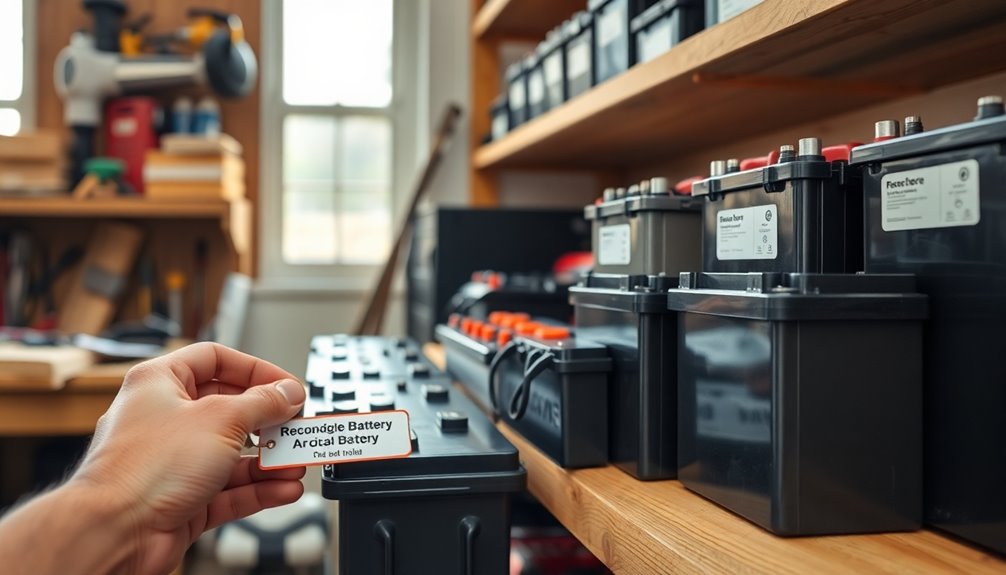
Choosing reconditioned batteries can lead to significant savings and environmental benefits, but knowing their ideal applications is just as important.
Reconditioned batteries are perfect for energy storage systems, especially when repurposed from electric vehicles (EVs). With 70-80% remaining capacity, they can support solar arrays and stabilize the electricity grid, reducing the need for new battery production. This aligns with the growing demand for batteries in the energy sector, emphasizing the importance of sustainable battery innovation.
For secondary vehicle use, reconditioned batteries fit older cars or those for short trips, where high performance isn't crucial. This not only extends the batteries' lifespan but also minimizes waste.
In industrial and commercial settings, these batteries shine as backup power systems or in material handling equipment. They're tested to meet specific needs, making them a cost-effective and eco-friendly choice.
Lastly, for residential and recreational uses—like home energy storage or powering boats—reconditioned batteries offer significant cost savings.
By utilizing these batteries in less demanding scenarios, you support sustainable practices while ensuring they continue to provide value beyond their original life in EVs.
With these applications, you can make smarter, greener choices for your energy needs.
Assessing Battery Lifespan
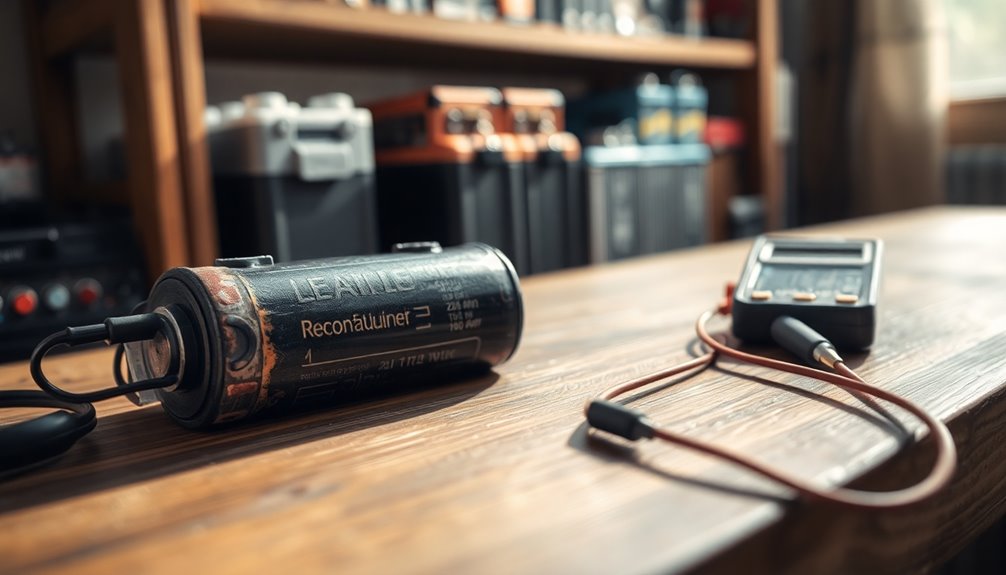
Understanding the factors that affect battery lifespan is crucial for maximizing the performance and value of reconditioned batteries. Temperature plays a significant role—optimal conditions hover around 25°C. Extreme temperatures can lead to capacity loss, as they influence the chemical reactions inside the battery. Maintaining a stable temperature is essential for enhancing battery longevity.
Cycling and depth of discharge (DOD) also matter. The more you charge and discharge, the shorter the cycle life becomes. To extend battery life, aim to keep your charge between 20% and 80%. Full cycles put extra stress on the battery, accelerating aging.
Additionally, consider the currents and charging rates. Higher currents generate excess heat, leading to mechanical degradation and increased internal resistance. Rapid charging can negatively impact lifespan, so always opt for gentler charging practices when possible.
Lastly, pay attention to the battery's age and prior use. Older batteries naturally have a reduced cycle life due to self-discharge and other factors.
Always assess the state of health (SoH) before making a purchase; a battery's history can reveal much about its future performance. By keeping these factors in mind, you can make informed choices regarding reconditioned batteries.
Understanding Warranty Options

When considering a reconditioned battery, what warranty options can provide peace of mind? Generally, warranties range from 1 year to 5 years, depending on the battery type. For example, a 36 month/45,000 mile warranty is typical for new complete hybrid batteries, while reconditioned batteries may come with a 1 year unlimited mileage warranty, like those from Green Bean Battery. Additionally, it's worth noting that new complete hybrid batteries come with a 36 Month/45,000 Mile No Hassle Warranty, ensuring you have robust coverage for your investment.
Transferability can boost your vehicle's resale value. Some warranties, like those from Hybrid Battery 911, allow you to transfer coverage to the next owner, provided you submit the new owner's details within 30 days.
However, keep in mind that warranties can be voided due to misuse, improper installation, or lack of maintenance.
Additional conditions may apply, such as the need for diagnostic paperwork for claims. Remember, you won't be liable for incidental damages, and some warranties even offer extension options for added security.
It's essential to read the fine print and understand what's covered and what's not before making your purchase. This way, you can confidently choose a reconditioned battery that meets your needs and protects your investment.
Frequently Asked Questions
How Do I Find a Reliable Source for Reconditioned Batteries?
To find a reliable source for reconditioned batteries, start by visiting local battery retailers and auto parts stores.
Check online marketplaces like eBay and Amazon, making sure to read reviews.
Look for specialized providers that focus on battery refurbishment and offer warranties.
Always verify that the refurbisher follows safety standards and conducts thorough testing.
Can Reconditioned Batteries Be Used in All Devices?
Reconditioned batteries can't be used in all devices.
You'll need to check the specifications of your device to ensure compatibility. Differences in voltage, size, and shape can lead to issues.
For devices that require specific voltage decay, like smoke detectors, using an incompatible battery might cause them to malfunction.
Always consult your device's owner's manual before making a decision to ensure the refurbished battery will work effectively.
What Is the Average Lifespan of a Reconditioned Battery?
The average lifespan of a reconditioned battery is typically one to two years.
However, this can vary based on your usage and how well you care for it.
Keep in mind that reconditioned batteries have a limited number of recharge cycles before they lose viability.
By managing temperature and avoiding deep discharges, you can help extend its life.
While they won't last as long as new batteries, they can still provide reliable performance.
Are There Any Safety Concerns With Reconditioned Batteries?
Yes, there are significant safety concerns with reconditioned batteries.
You should be aware that they carry a higher risk of explosion and overheating due to unstable chemical reactions. Internal defects can lead to bulging or short-circuit problems, increasing fire hazards.
Since refurbished batteries often lack reliable quality guarantees, it's tough to assess their true condition.
Always prioritize safety by handling them carefully and considering these risks before using or purchasing refurbished batteries.
How Do I Properly Maintain a Reconditioned Battery?
To properly maintain a reconditioned battery, start by charging it when it drops to 20% capacity and let it fully charge without interruptions.
Regularly check the electrolyte levels for flooded lead-acid batteries, adding distilled water as needed.
Clean the terminals to prevent corrosion and perform load tests to monitor performance.
Always handle water carefully, ensuring the battery cools down before adding it, and keep an eye on any signs of overheating.
Conclusion
In conclusion, buying reconditioned batteries can be a smart choice for both your wallet and the environment. They offer substantial cost savings while reducing waste. Just remember to assess their performance against your needs and consider warranty options for peace of mind. Whether you're powering tools, gadgets, or renewable energy systems, reconditioned batteries can be reliable and efficient. So, weigh the factors, and when the time's right, make that sustainable switch!

